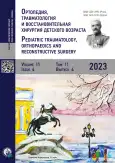Phenotypic variability in children with Bruck syndrome type 2: Clinical cases
- Authors: Trofimova S.I.1, Kochenova E.A.1, Agranovich O.E.1, Buklaev D.S.1, Merkuryeva E.S.2, Markova T.V.2
-
Affiliations:
- H. Turner National Medical Research Center for Children’s Orthopedics and Trauma Surgery
- Research Centre for Medical Genetics
- Issue: Vol 11, No 4 (2023)
- Pages: 537-545
- Section: Clinical cases
- URL: https://journal-vniispk.ru/turner/article/view/251912
- DOI: https://doi.org/10.17816/PTORS569365
- ID: 251912
Cite item
Abstract
BACKGROUND: Bruck syndrome is a rare disorder that features osteogenesis imperfecta, combined with severe congenital joint contractures often with pterygia, short stature, severe limb deformities, and progressive scoliosis. Its two forms, Bruck syndrome types 1 and 2, have similar clinical manifestations without osomal recessive inheritance and are caused by pathogenic variants of the nucleotide sequences in the FKBP10 and PLOD2 genes, respectively.
CLINICAL CASES: The article demonstrates phenotypic and radiographic features as well as laboratory values of siblings with Bruck syndrome type 2 (a 10-year-old boy and a 13-year-old girl) born to healthy parents in a consanguineous marriage. The boy had congenital flexion contractures of the knee and elbow joints, few fractures, and severe kyphoscoliosis. The girl had no congenital joint contractures but had kyphoscoliosis, more severe osteoporosis, and a history of having more fractures than her younger brother.
DISCUSSION: The cases demonstrated the significant phenotypic intrafamilial variability of Bruck syndrome type 2, caused by a newly identified homozygous variant c.1885A>G (p.Thr629Ala) in PLOD2, which consists of varying degrees of osteoporosis, and the presence and severity of contractures.
CONCLUSIONS: The description of the given clinical observation was made to draw attention to a rare pathology and expand doctors’ knowledge about the variability of clinical manifestations of Bruck syndrome. Genetic diagnostics is necessary for the timely diagnosis of Bruck syndrome, determining the prognosis and developing patient management techniques.
Full Text
##article.viewOnOriginalSite##About the authors
Svetlana I. Trofimova
H. Turner National Medical Research Center for Children’s Orthopedics and Trauma Surgery
Author for correspondence.
Email: trofimova_sv2012@mail.ru
ORCID iD: 0000-0003-2690-7842
SPIN-code: 5833-6770
MD, PhD, Cand. Sci. (Med.)
Russian Federation, Saint PetersburgEvgeniia A. Kochenova
H. Turner National Medical Research Center for Children’s Orthopedics and Trauma Surgery
Email: jsummer84@yandex.ru
ORCID iD: 0000-0001-6231-8450
SPIN-code: 4346-5431
MD, PhD, Cand. Sci. (Med.)
Russian Federation, Saint PetersburgOlga E. Agranovich
H. Turner National Medical Research Center for Children’s Orthopedics and Trauma Surgery
Email: olga_agranovich@yahoo.com
ORCID iD: 0000-0002-6655-4108
SPIN-code: 4393-3694
MD, PhD, Dr. Sci. (Med.)
Russian Federation, Saint PetersburgDmitry S. Buklaev
H. Turner National Medical Research Center for Children’s Orthopedics and Trauma Surgery
Email: dima@buklaev.com
ORCID iD: 0000-0003-1868-3703
SPIN-code: 4640-6856
MD, PhD, Cand. Sci. (Med.)
Russian Federation, Saint PetersburgElena S. Merkuryeva
Research Centre for Medical Genetics
Email: elena.merkureva@gmail.com
ORCID iD: 0000-0001-6902-253X
MD, PhD student, geneticist
Russian Federation, MoscowTatiana V. Markova
Research Centre for Medical Genetics
Email: markova@med-gen.ru
ORCID iD: 0000-0002-2672-6294
SPIN-code: 4707-9184
MD, PhD, Cand. Sci. (Med.)
Russian Federation, MoscowReferences
- Mumm S, Gottesman GS, Wenkert D, et al. Bruck syndrome 2 variant lacking congenital contractures and involving a novel compound heterozygous PLOD2 mutation. Bone. 2020;130. doi: 10.1016/j.bone.2019.115047
- Luce L, Casale M, Waldron S. A rare case of Bruck syndrome type 2 in siblings with broad phenotypic variability. Ochsner J. 2020;20(2):204–208. doi: 10.31486/toj.18.0145
- McPherson E, Clemens M. Bruck syndrome (osteogenesis imperfecta with congenital joint contractures): review and report on the first North American case. Am J Med Genet. 1997;70(1):28–31.
- Bank RA, Robins SP, Wijmenga C, et al. Defective collagen crosslinking in bone, but not in ligament or cartilage, in Bruck syndrome: indications for a bone-specific telopeptide lysyl hydroxylase on chromosome 17. Proc Natl Acad Sci USA. 1999;96(3):1054–1058. doi: 10.1073/pnas.96.3.1054
- Lietman CD, Rajagopal A, Homan EP, et al. Connective tissue alterations in Fkbp10-/- mice. Hum Mol Genet. 2014;23(18):4822–4831. doi: 10.1093/hmg/ddu197
- Moravej H, Karamifar H, Karamizadeh Z, et al. S. Bruck syndrome – a rare syndrome of bone fragility and joint contracture and novel homozygous FKBP10 mutation. Endokrynol Pol. 2015;66(2):170–174. doi: 10.5603/EP.2015.0024
- Van der Slot AJ, Zuurmond AM, Bardoel AF, Wijmenga C, et al. Identification of PLOD2 as telopeptide lysyl hydroxylase, an important enzyme in fibrosis. J Biol Chem. 2003;278(42):40967–40972. doi: 10.1074/jbc.M307380200
- Leal GF, Nishimura G, Voss U, et al. Expanding the clinical spectrum of phenotypes caused by pathogenic variants in PLOD2. J Bone Miner Res. 2018;33(4):753–760. doi: 10.1002/jbmr.3348
- Richards S, Aziz N, Bale S, et al.; ACMG Laboratory Quality Assurance Committee. Standards and guidelines for the interpretation of sequence variants: a joint consensus recommendation of the American College of Medical Genetics and Genomics and the Association for Molecular Pathology. Genet Med. 2015;17(5):405–424. doi: 10.1038/gim.2015.30
- Buklaev DS, Kostik MM, Agranovich OE, et al. Bruck syndrome: a case report. Pediatric Traumatology, Orthopaedics and Reconstructive Surgery. 2015;3(3):44–47. (In Russ.) doi: 10.17816/PTORS3344-47
- Ha-Vinh R, Alanay Y, Bank RA, et al. Phenotypic and molecular characterization of Bruck syndrome (osteogenesis imperfecta with contractures of the large joints) caused by a recessive mutation in PLOD2. Am J Med Genet A. 2004;131(2):115–120. doi: 10.1002/ajmg.a.30231
- Kelley BP, Malfait F, Bonafe L, et al. Mutations in FKBP10 cause recessive osteogenesis imperfecta and Bruck syndrome. J Bone Miner Res. 2011;26(3):666–672. doi: 10.1002/jbmr.250
Supplementary files











